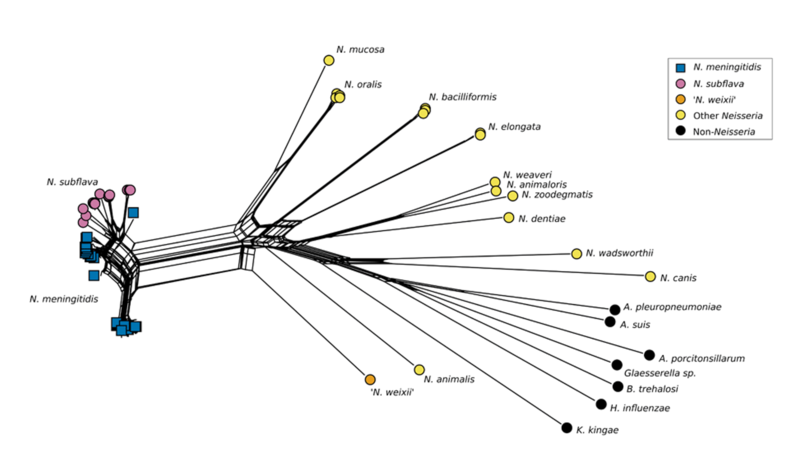Horizontal Gene Transfer in the Meningococcal Capsule Locus
Genomic data is used by scientists and doctors around the world to respond to the threat of infectious diseases. In this series of blog posts, we’ll highlight research carried out by our group that uses genomic data to study disease-causing bacteria. The discoveries you are making through the Genome Detectives project will help us carry out more studies like these in the future!

This post discusses research into the evolutionary origins of the capsule locus (a group of genes encoding instructions to make the cell’s external layer) in Neisseria meningitidis. The full scientific paper is: “Neisseria meningitidis Has Acquired Sequences Within the Capsule Locus by Horizontal Genetic Transfer” (Clemence, et al., 2019). If you’d like to read it, you can find it here.
The Neisseria meningitidis capsule
Neisseria meningitidis, often called the meningococcus, is typically carried harmlessly in the nose and throat. However, the meningococcus can sometimes invade the bloodstream and cause severe infections including meningitis and septicaemia, collectively known as invasive meningococcal disease (IMD).
In the vast majority of IMD cases, N. meningitidis expresses a polysaccharide (a type of carbohydrate molecule) capsule on the outer surface of the cell. Thirteen different types of capsular polysaccharides have been described1, and the presence of each one defines each serogroup (subtype) of N. meningitidis. Six serogroups – A, B, C, W, X, and Y – are associated with IMD.
Some N. meningitidis variants do not have a polysaccharide capsule and are not associated with disease – these are known as ‘capsule null’.
The capsule locus
There are several genes required for expression of the polysaccharide capsule, which are located next to each other on the chromosome in a region known as the capsule locus (the cps). These include genes encoding instructions for the synthesis of the capsule (cps region A), and genes encoding instructions for the export of the molecules to the surface of the cell (cps regions B and C). The allele present at region A determines the serogroup.
Species of Neisseria that are most closely related to N. meningitidis (for example N. gonorrhoeae, N. lactamica, and N. polysaccharea) are consistently capsule null. This has led to the hypothesis that the cps in the meningococcus has been acquired by horizontal gene transfer (HGT) from more distantly-related Neisseria species or even from a different bacterial genus (a group of related species). HGT is the movement of genetic material between bacterial cells which are not directly ‘parent’ and ‘offspring’ (transmission of genes during reproduction is referred to as vertical transmission).
Neighbour-net analyses
To investigate this hypothesis, Clemence and colleagues used genome data from meningococcal samples, other Neisseria species, and samples of species from other bacterial genera that express a capsule similar to the meningococcal capsule. They used computer software to predict whether HGT had occurred, and if so from which species, by comparing the N. meningitidis cps sequences to cps sequences from the other species.
The researchers generated ‘neighbour nets’, a type of phylogeny (a branching diagram which shows the evolutionary relationships between various species). The length of each line between two dots represents the evolutionary distance between those species, with a longer line meaning they are more distantly related. Where there are multiple lines, forming a net, this represents different possible arrangements of the evolutionary relationships between the species.

The diagram shows a neighbour net constructed from cps region B sequences. The analysis shows a well-supported grouping of N. meningitidis and N. subflava sequences together and apart from the other species. There was also some support in the cps region B neighbour-net analysis for an alternative grouping of some N. meningitidis samples with N. weixii. Similar groupings were seen in analysis of cps region C.
Neisseria subflava and Neisseria weixii

The analyses carried out by Clemence and colleagues suggest that the meningococcal cps locus contains ‘recombinant’ sequences – sequences which have been obtained via HGT. The phylogenetic pattern suggests that the main donor species of these sequences was Neisseria subflava. This is biologically conceivable, since N. meningitidis and N. subflava are both carried by humans in the nose and throat and so could feasibly interact to share genetic material.
The sequence analysis also suggests some evidence for a second species, Neisseria weixii, having donated cps sequences to N. meningitidis through HGT. However, interaction between these two species seems unlikely as N. meningitidis is only found in humans while N. weixii samples come from the plateau pika, a small mountain-dwelling mammal. It is possible instead that a human-associated Neisseria species not yet been identified, which is more closely related to N. weixii, was the source of these sequences.
A possible evolutionary pathway
Overall, the analyses carried out by Clemence and colleagues show that the meningococcal cps locus has undergone horizontal gene transfer from other Neisseria species. The data is consistent with a hypothesis where a capsule null N. meningitidis variant acquired the capsule locus genes from N. subflava, and additional HGT from other species including N. weixii subsequently occurred.
It is possible that the capsule was inherited by descent from a Neisseria meningitidis ancestor (i.e. vertical transmission), however the lack of capsule genes in any of the most closely related species (Neisseria gonorrhoeae, lactamica, and polysaccharea) suggests a more likely evolutionary pathway was capsule loss in the common ancestor and reacquisition via HGT in N. meningitidis.
The acquisition of the cps locus would have had important epidemiological consequence, since the capsule is present in the infecting strain of almost all cases of IMD. Further characterisation of cps genes in other Neisseria species, particularly if new human-associated species are found, may provide more insight into the complex evolutionary history of the capsule locus.
Summary
The genome-based analyses carried out by Clemence and colleagues suggest that multiple horizontal gene transfer events have occurred at the capsule locus between Neisseria meningitidis and N. subflava, and also with N. weixii or another closely related species.
If you are keen to discover more about the evolution of the Neisseria meningitidis capsule locus, you can read the paper by Clemence, et al., here.
Images (in order): Encyclopaedia Britannica, 2021; Clemence, et al., 2019; Wikipedia, 2006.


